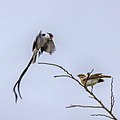| Pin-tailed whydah | |
|---|---|

| |
| male in breeding plumage São Tomé and Príncipe | |
| Conservation status | |
 Least Concern (IUCN 3.1) | |
| Scientific classification | |
| Domain: | Eukaryota |
| Kingdom: | Animalia |
| Phylum: | Chordata |
| Class: | Aves |
| Order: | Passeriformes |
| Family: | Viduidae |
| Genus: | Vidua |
| Species: | V. macroura |
| Binomial name | |
| Vidua macroura (Pallas, 1764) | |
| Synonyms | |
| |
The pin-tailed whydah (Vidua macroura) is a small songbird with a conspicuous pennant-like tail in breeding males. It is a resident breeding bird in most of Africa south of the Sahara Desert.
Taxonomy
The pin-tailed whydah was first described by the German naturalist Peter Simon Pallas in 1764 and given the binomial name Fringilla macroura.
Description
The pin-tailed whydah is 12–13 cm in length, although the breeding male's tail adds another 20 cm to this. The adult male has a black back and crown, and a very long black tail. The wings are dark brown with white patches, and the underparts and the head, apart from the crown, are white. The bill is bright red. The female and non-breeding male have streaked brown upperparts, whitish underparts with buff flanks, and a buff and black face pattern. They lack the long tail extension, but retain the red bill. Immature birds are like the female but plainer and with a greyish bill.
Distribution and habitat
The pin-tailed whydah occurs in much of sub-Saharan Africa, favouring grassland, scrubs and savannah, also coming into parks and gardens. In Portugal it is established in the region around Aveiro, with observations occurring north and south of it. It has been introduced to southern California, with a sizable population existing there, as well as Puerto Rico and Singapore. It is also widely kept as a cage bird elsewhere, with occasional escapes and releases.
Ecology
The species is a brood parasite which lays its eggs in the nests of estrildid finches, especially waxbills. Unlike the common cuckoo, it does not destroy the host's eggs. Typically, 2–4 eggs are added to those already present. The eggs of both the host and the whydah are white, although the whydah's are slightly larger. The nestling whydahs mimic the gape pattern of the fledglings of the host species.
The male pin-tailed whydah is territorial, and one male often has several females in his small group. He has an elaborate courtship flight display, which includes hovering over the female to display his tail. The song is given from a high perch, and consists of rapid squeaking and churring. The diet of this species consists of seeds and grain.
Gallery
-
 male in breeding plumage
male in breeding plumage
Londolozi Private Game Reserve, South Africa -
 male in non-breeding plumage
male in non-breeding plumage
Lake Bunyonyi, Uganda -
 female
female
Lake Bunyonyi, Uganda -
 male displaying to female, São Tomé and Príncipe
male displaying to female, São Tomé and Príncipe
-
 Vidua macroura in a clutch of Lonchura cucullata - MHNT
Vidua macroura in a clutch of Lonchura cucullata - MHNT
References
- ^ BirdLife International (2018). "Vidua macroura". IUCN Red List of Threatened Species. 2018: e.T22719988A132134939. doi:10.2305/IUCN.UK.2018-2.RLTS.T22719988A132134939.en. Retrieved 12 November 2021.
- Paynter, Raymond A. Jnr., ed. (1968). Check-list of birds of the world, Volume 14. Cambridge, Massachusetts: Museum of Comparative Zoology. p. 395.
- Sherborn, C. Davies (1905). "The new species of birds in Vroeg's catalogue, 1764". Smithsonian Miscellaneous Collections. 47: 332–341 . Includes a transcript of the 1764 text.
- Rookmaaker, L.C.; Pieters, F.F.J.M. (2000). "Birds in the sales catalogue of Adriaan Vroeg (1764) described by Pallas and Vosmaer". Contributions to Zoology. 69 (4): 271–277. doi:10.1163/18759866-06904005.
- ^ SInclair, Ian; Hockey, Phil; Tarboton, Warwick; Ryan, Peter (2011). Sasol Birds of Southern Africa (4th ed.). Cape Town: Struik Nature.
- Viuvinha-bico-de-lacre – Aves de Portugal
- ^ "The Pin-Tailed Whydah – Fact Sheet". Finch Information Center.
Further reading
Pin-tailed whydah – Species text in The Atlas of Southern African Birds.
External links
| Taxon identifiers | |
|---|---|
| Vidua macroura |
|
| Fringilla macroura | |